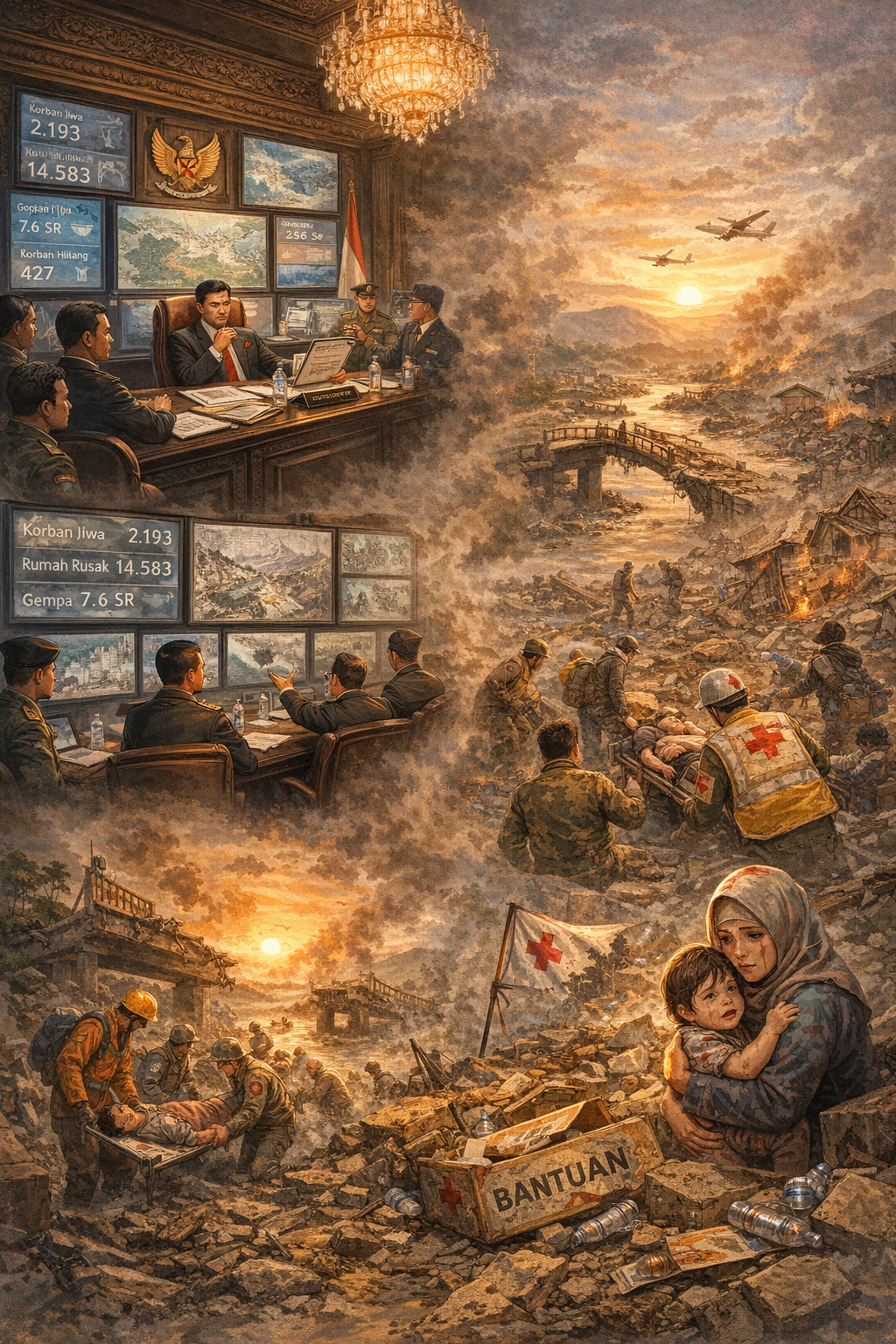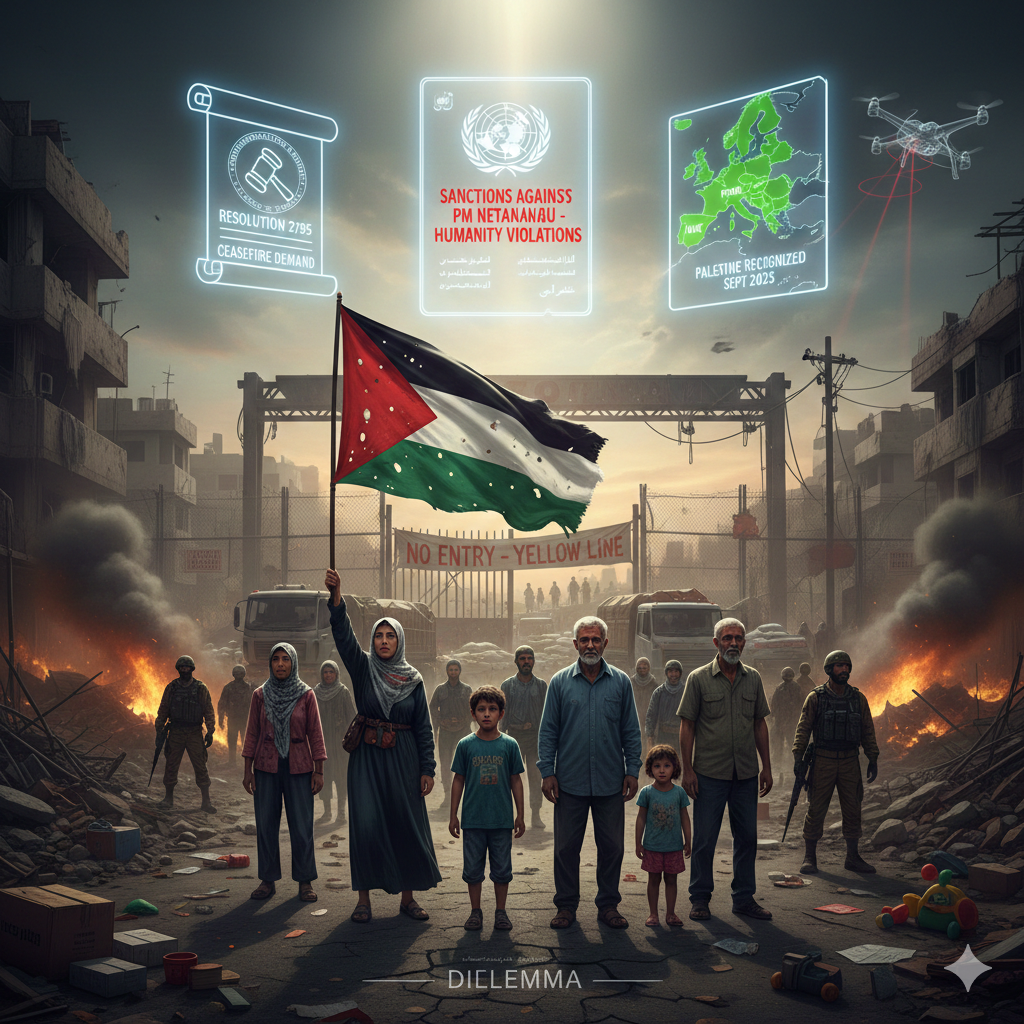Gia Ayu Fita
Universitas Sulawesi Barat
giaayufita@unsulbar.ac.id
Introduction
The Israel Palestine conflict is one of the longest and most complex international disputes in modern history. It has continued for over seventy years since Israel was established in 1948, and the search for a peace agreement that both sides can accept is ongoing. The Two-State Solution (2SS) is still the main framework supported by the United Nations and most countries. However, putting the 2SS into practice faces serious challenges, including disagreements over borders, the status of Jerusalem, the rights of Palestinian refugees, and the growth of Israeli settlements in the West Bank. Experiences from other conflicts, like the Dayton Agreement in Bosnia in 1995, show that strong international monitoring and enforcement are needed to make sure peace agreements are effective. This paper looks at the 2SS from the perspective of international law, reviews Dayton-style verification methods, and compares them to the situations in Bosnia, Kosovo, and Timor-Leste. It also considers the Trump Peace Plans of 2020 and 2025 and explores whether combining the 2SS with Dayton-style verification could offer a more practical, though very challenging, path to peace.
The Use of International Legal Frameworks and International Relations Theory
In the case of the Israel–Palestine conflict, international law provides the basic normative principles for resolving the dispute. The United Nations Charter prohibits the use of force (Article 2(4)) and affirms the right of peoples to self-determination (Article 1(2)). These principles implicitly reject the acquisition of territory through war and support the Palestinian claim to establish an independent state (United Nations, 1945).
Following the Six-Day War, UN Security Council Resolution 242 (1967) reaffirmed the “inadmissibility of the acquisition of territory by war” and called for Israel’s withdrawal from the occupied territories. Resolution 1397 (2002) explicitly affirmed the vision of a two-state solution for the first time, while Resolution 1515 (2003) endorsed the Roadmap toward a permanent settlement. More recently, Resolution 2334 (2016) declared that Israeli settlements in the occupied Palestinian territories “have no legal validity” and threaten the viability of a two-state solution (United Nations Security Council [UNSC], 1967, 2002, 2003, 2016).
Similarly, the International Court of Justice (ICJ), through its 2004 advisory opinion on the construction of the separation wall and its 2024 opinion on the prolonged occupation, affirmed that Israel’s policies in the Palestinian territories violate international law and that all states are obligated not to recognize such illegal situations (International Court of Justice [ICJ], 2004, 2024).
International Relations theory views the conflict as a classic security dilemma. Israel looks for strong security guarantees, while Palestinians seek sovereignty. Security studies also highlight the need for verification regimes, which help ensure that both sides adhere to peace agreements (Fortna, 2004).
Two-State Solution: Normative Basis and Challenges
The normative basis of the Two-State Solution (2SS) envisions the establishment of both Israel and Palestine as sovereign states with secure and recognized borders. Specifically, the 1967 ceasefire line (the Green Line) serves as a reference point, with the possibility of limited, mutually agreed land swaps. In principle, the Palestinian state must be “viable, contiguous, and sovereign.”
Despite this normative vision, implementing the 2SS faces several major challenges. First, Palestinian territory is now fragmented. Ongoing Israeli settlement growth in the West Bank has resulted in separated areas, which present logistical difficulties for achieving a contiguous Palestinian state. Second, Jerusalem is a highly sensitive issue, as both parties claim. Third, more than 5 million Palestinian refugees, according to UNRWA, have yet to see an agreed solution.
Some Israeli security analysts suggest that a 2SS without robust security arrangements could be fragile. As Yanai (2005) observed, “a two-state scenario opens the door to greater security challenges for Israel … only strong and stable security arrangements can lead to a lasting, stable peace.” This observation points to the potential need for additional mechanisms beyond the political agreement itself.
Dayton-style Verification: Mechanisms and Relevance
The Dayton Agreement of 1995, which ended the Bosnian war, is a key example of international verification in practice. Annex 1-A covered military issues like troop withdrawals, demilitarized zones, and limits on heavy weapons, with NATO’s IFOR and SFOR overseeing these steps. Annex 1-B set up an arms control system, monitored by the OSCE. The agreement also established the High Representative’s role to oversee the process, with special powers to remove local officials who obstructed peace efforts.
Dayton’s verification measures were designed to ensure all parties adhered to the agreement, alleviate security concerns, and lend the process international credibility. Without these checks, the agreement probably would not have succeeded.
In the context of the Israel–Palestine conflict, similar mechanisms could, in principle, be envisioned, such as:
- A multinational force monitoring borders and demilitarization,
- Weapons inspections conducted by a neutral third party,
- An international regime for Jerusalem,
- Human rights monitoring and facilitation of refugee return.
The main challenge is that, unlike Bosnia, Israel does not accept international oversight in its territory, and Palestinians do not trust the United States or NATO. As a result, it is extremely challenging to identify a genuinely impartial third party (Zartman, 2001).
Comparative Cases: Bosnia, Kosovo, and Timor-Leste
The Bosnian conflict in 1995 was mainly an inter-ethnic war that ended with a division of territory: 51% went to the Bosniak-Croat Federation and 49% to Republika Srpska. This situation did not involve a dispute between two sovereign states. Verification mechanisms helped end the war, but Bosnia has stayed fragile and divided (Chandler, 2000).
In 1999, the conflict in Kosovo between Serbia and ethnic Albanians resulted in international administration by UNMIK and the arrival of KFOR peacekeepers. While verification efforts have kept the area secure, Kosovo’s statehood remains disputed (Ker-Lindsay, 2009).
Between 1999 and 2002, a UN-supervised referendum in Timor-Leste led to independence from Indonesia. UNTAET oversaw the transition until 2002. Unlike the situation in Palestine, Indonesia agreed to relinquish control, allowing international administration to work smoothly (Chopra, 2000).
The Israel-Palestine conflict stands out because it centers on a struggle over land between two groups. Israel, as a recognized state, keeps expanding its control, while Palestine has lost much of its territory. As a result, there is no truly comparable case.
Evaluation of the Trump Peace Plan 2020
In 2020, President Donald Trump introduced the Peace to Prosperity plan. The document described itself as a “realistic two-state solution,” but its main features were as follows:
- The plan offered a limited two-state solution. Palestine would get about 70% of the West Bank, divided into separate areas, and East Jerusalem would stay under Israeli control.
- There was no final peace agreement because the proposal was made by one side without involving talks with the Palestinians.
- There was no independent Dayton-style verification mechanism in place. Security was to be fully controlled by Israel, with Palestine required to undergo demilitarization (White House, 2020).
The 2020 plan was widely criticized internationally. As Al Jazeera (2020) noted, “Trump’s ceasefire plan has no guarantees for the Palestinians and, once again, favours the Israelis.”
Evaluation of the Trump Peace Plan 2025
In September 2025, Trump introduced another peace plan. This version focused mainly on Gaza and included 20 main points:
- An immediate ceasefire and the exchange of hostages within 72 hours.
- The demilitarization of Gaza and the dismantling of Hamas.
- The establishment of a Palestinian technocratic transitional authority under international supervision.
- The deployment of an International Stabilization Force (ISF) composed of Arab states and international partners to monitor security.
- A phased withdrawal of Israeli forces from Gaza, subject to security guarantees.
- A conditional pathway toward Palestinian self-determination, though without guaranteeing full statehood.
The 2025 plan focused more on security and transition steps than the 2020 plan. The new ISF was similar to Dayton-style verification, but it only applied to the Gaza Strip. The plan did not address key issues, such as the West Bank, Israeli settlements, or Jerusalem (BBC, 2025).
References
Al Jazeera. (2020). Trump’s Middle East Peace Plan: Key Points. Retrieved 2025, from https://www.aljazeera.com
BBC. (2025). Donald Trumps Unveils New Gaza Peace Plan. Retrieved 2025, from https://www.bbc.com/news/articles/c70155nked7o
Chandler, D. (2000). Bosnia: Faking Democracy After Dayton . London : Pluto Press.
Chopra, J. (2000). The UN’s Kingdom of East Timor. Survival, 42(3), pp. 27-39.
Fortna, V. (2004). Peace Time: Cease-fire Agreements and the Durability of Peace. Princeton, NJ: Princeton University Press.
ICJ. (2004). Legal Consequences of the Construction of a Wall in the Occupied Palestinian Territory (Advisory Opinion). International Court of Justice. The hague: International Court of Justice.
Ker-Lindsay, J. (2009). Kosovo: The Path to Contested Statehood in the Balkans . London: I.B. Tauris.
Nations, U. (1945). Charter of the United Nations. San Fransisco, CA: United Nations.
UNSC. (1967, 2002, 2003, 2016). New York: United Nations Security Council.
White House. (2020). Peace to Prrosperity: A Vision ti Omprove the LIves of The Palestinian and Israeli People. Washington, DC: White House.
Yanai, A. (2005). Israel’s Core Security Requirements for a Two-State Solution. Washinton, DC: Brookings Institution.
Zartman, I. (2001). The Timing of Peace Initiatives; G=Hurting Stalemates and Ripe Moments. The Global Review of Ethnopolitics, 1(1), 8-18.


